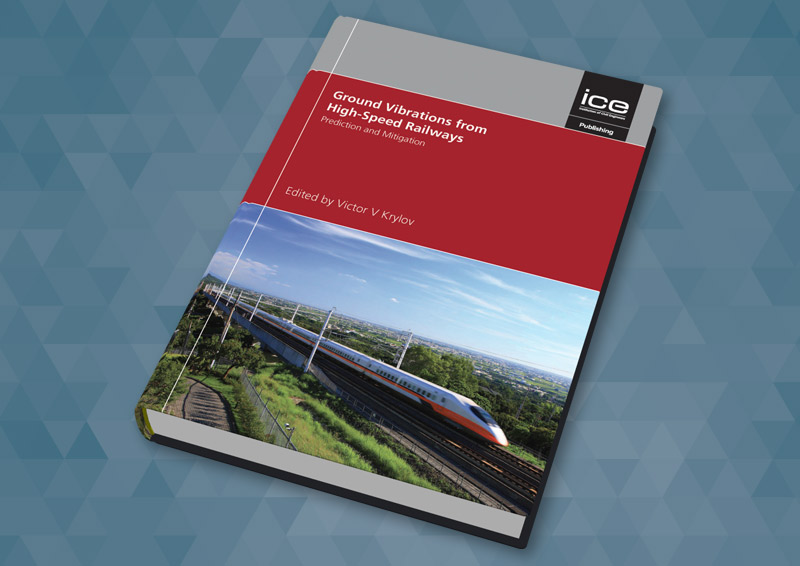Victor Krylov, the editor of Ground vibrations from high-speed railways: Prediction and mitigation, discusses ways of making high-speed railways safer and reducing their ground vibration impact.

- Updated: 29 May 2020
- Author: Author: Victor V. Krylov, Professor of Acoustics and Vibration at Loughborough University, UK
In recent years, high-speed railways have been developing very quickly throughout the world. Due to their increased speeds and low air pollution, high-speed railways have become a viable alternative to air transport for travelling at short and medium distances. Operational speeds close to or greater than 300 km/h are now typical for high-speed railways, and train speeds still continue to grow. For example, the operational speed of the new proposed high-speed railway network HS2 to be built in the UK is expected to be up to 400 km/h in the 2030s.
Increased train speeds are usually associated with increased levels of railway noise and vibration. Railway-induced ground vibrations consist mostly of Rayleigh surface elastic waves that can propagate through the ground to nearby buildings, causing annoyance to locals both directly and via associated air-borne noise. The development of high-speed railways brings into consideration new ground vibration problems that were unknown for conventional trains travelling at lower speeds. When train speeds become large enough, i.e., larger than certain velocities of elastic waves propagating in the supporting ground or in more complex systems involving tracks, ground and embankments, some specific vibration generation mechanisms can occur. These may cause substantial increases in levels of vibrations both in rail track systems and in the supporting ground. A very large increase in generated ground vibrations may occur if train speeds exceed the velocity of Rayleigh surface waves if the supporting ground is relatively soft. If this happens, a 'ground vibration boom' takes place, like a 'sonic boom' from a supersonic aircraft.
The essential difference between a sonic boom and a ground vibration boom is that, whereas sound velocity in air is roughly the same in all locations above the earth surface, the Rayleigh wave velocity in the ground is different in different locations, depending on local geological properties of the ground. As a rule, train speeds even as high as 400 km/h are still lower than Rayleigh wave velocities in the ground in the majority of locations. In some locations, where the ground is soft and marshy, the Rayleigh wave velocity can be very low, so that it can be exceeded by high train speeds. It is these 'sensitive' locations that are most at risk of the occurrence of a ground vibration boom from operating high-speed trains. The phenomenon of ground vibration boom could represent a serious environmental hazard to be reckoned with. Indeed, the levels of generated ground vibrations associated with ground vibration boom can be 10-20 times higher than their levels in locations with higher Rayleigh wave velocities, where ground vibration boom does not happen.
The effects of critical velocities associated with guided elastic waves propagating in tracks along with ground vibrations may cause substantial rail deflections. Such deflections may even result in train derailment, a big safety concern for high-speed railway operators. All these complex problems involving elastic wave propagation in track and ground systems, the interaction of these coupled systems with moving trains, as well as the final impact of generated ground vibrations on nearby buildings, should be studied in detail to understand and control the associated complex dynamic phenomena. These studies should also include possible mitigation measures to reduce generated ground vibrations and their impact on the environment.
Over the last few years, many new interesting and important investigations have been carried out in the field of railway-induced ground vibrations. In particular, substantial progress has been made in the studies of critical velocities in realistic track-ground systems and their effects on generated ground vibrations. New theoretical and numerical approaches, including two-and-half dimensional approaches and hybrid methods, have been developed for the prediction and possible mitigation of ground vibrations from surface and underground railways. The effects of layered soils and different types of embankments on generated ground vibrations have been thoroughly investigated both theoretically and experimentally.
Ground Vibrations from High-Speed Railways: Prediction and mitigation presents in one volume, the views of leading international experts in ground vibrations from high-speed trains on the current status of the problem and discusses possible ways of reducing their environmental impact.
Find out more about the theoretical and practical aspects of train-induced dynamic phenomena in Ground vibrations from high-speed railways: Prediction and mitigation, available in print and as an eBook.
